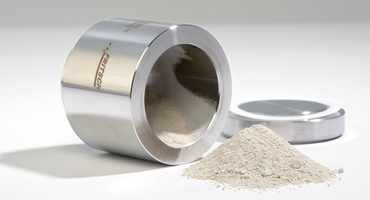Torna alla panoramica
Milling tests with the Fritsch Planetary Ball Mill
Comminution of mineral fertilizers down to nanoparticles
Introduction
- Nanotechnology widely deals with nanoscale particle between 1-100 nm1.
- Alternative definition of nano fertilizer (larger particle size): fertilizer which particle size is smaller than 500 mm and altered properties2.
- Nanoparticles can be synthesized or produced by physical, chemical, biological and aerosol techniques. Physical synthesis methods include sedimentation processes, rotor speed mills, high energy ball mills and mixer mills.
- In general, phosphorus (P) nanoparticles are prepared by purifying rock phosphate and grinding them with a high energy ball mill or mixer mill smaller than 500 nm and altered properties2.
- This report describes the experimental trial and results of mineral fertilizer grinding using FRITSCH premium line Planetary Mills (High Energy Ball Mills) to obtain nanosize particles.
Methodology
Fertilizer samples:
There are two kind of mineral fertilizer obtained, processed and tested and comminuted using a high energy ball mill at the FRITSCH Laboratory in the - German Center, Singapore, which consisted of:
1. Rock phosphate (ground)
2. Kieserite (granular)
Laboratory Mills and Particle Size Analyzers
The laboratory mill used for the trials was the FRITSCH Planetary Micro Mill PULVERISETTE 7 premium line equipped with the following items:
- Grinding Bowls (2 x 80 ml)
- Grinding Balls (25 x 10 mm)
- Grinding Balls (5 x 20 mm)
Another laboratory instrument used was the Laser Particle Sizer ANALYSETTE 22, that can measure particle size distribution with a range of 0.01 – 3800 µm.
Experimental Trial
Grinding tests of the fertilizer samples using Planetary Mills were conducted at the FRITSCH office and laboratory of the German Center in Singapore. Mr. Diels Ding as an expert in grinding processes, as well as Business Manager for Asia Pacific – Fritsch GmbH directly conducted the trials. He also provided informative insights and a meaningful discussion ensued about grinding and milling processes and nanomaterial. The samples were tested in dry and wet conditions for the milling process, with the following description:
Table 1: Grinding Trial of the fertilizer samples with various parameters
No | Sample | Milling Type | Time | Code | Other Parameters |
1. | Rock Phosphate | Dry | 3 | RP-D-5 | Grinding bowl: 80 ml Sample: 25 g Grinding balls: 25 x 10 mm Speed: 850 rpm |
2. | Rock Phosphate | Wet (tap water) | 3 | RP-W-5 | |
3. | Rock Phosphate | Dry | 30 | RP-D-30 | |
4 | Rock Phosphate | Wet (tap water) | 30 | RP-W-30 | |
5. | Kieserite | Dry | 5 | Kie-D-5 | Grinding Bowl: 80 ml Sample: 25 g Grinding Balls: 25 x 10 mm Speed: 700 rpm |
6. |
Kieserite |
Wet (tap water) |
5 |
Kie-W-5 | |
7. | Kieserite | Dry | 5 | Kie-D-5 (B)* | *Larger grinding balls: 5 x 20 mm |
* Table 2: Result of the grinding process of samples, photos and particle size distribution in the report for download.
Questions and Issues:
1. Is it possible or not to grind the fertilizer samples and reach nano size particles less than (<) 100 nm? Yes, it’s possible, but this is challenging due the following:
- Several steps of milling processes are needed with various size of grinding balls (20 mm to 0.1 mm), it could take longer (several hours)
- Various particle size distributions, cannot be uniform in desired nano size; all or larger particle sizes may still exist in a significant percentage.
- Product recovery: after milling, the next challenge is the separation of the milled sample from the small grinding balls - (for large grinding balls it is easy, but for very small grinding balls* it could be difficult). *High consumption of very small grinding balls
- For nano size milling, this should be wet milling, therefore a proper solvent must be used, water cannot be utilized for every type of fertilizer and other solvents such as Iso-Propanol etc. could mean additional costs.

2. What is the capacity of milling we want?
The Planetary Mill PULVERISETTE 5 premium line provides two stations of grinding bowls with 500 ml volume (largest capacity on the market). Each grinding bowl can be filled 1/3 part of the volume (± 170 gr sample). So, if we use two grinding bowls, the optimum capacity is about 170 x 2 = 340 g per milling process.
3. What is the real purpose and goals?
Consideration of the value vs. benefits obtained from this research and high investment costs.
4. How do we handle and apply the product of nano fertilizers into the field?
If the milling process is successful in getting and achieving the targeted nano size fertilizer sample, then the next challenge is applying the product in the field properly and safely for humans and the environment.
About nanotechnology and nanomaterial
Only established companies apply the technology since the investment costs are substantial with high quality and precision of research, such as IT, energy, paint and the coatings industry etc.
-
Download the FRITSCH-report as PDF file
-
Sources and interesting links
[1] Tarafdar, J. C. Nanoparticle Production , Characterization and its Application to Horticultural Crops. 222–229 (2015).
[2] PRITISH PRIYADARSHI SWAIN. Presentation Seminar: Use of Nano Fertilizer in Agriculture.
Torna alla panoramica








